Federal Judge Questions Involvement in Napa Wine Dispute
In a recent hearing held on Friday, a federal judge raised significant questions regarding his role in a contentious legal dispute between Napa County and a local vineyard. The case, which has garnered considerable attention, is currently making its way through the state courts of California. The judge’s skepticism about presiding over the matter highlights the complexities involved in legal jurisdiction and the interplay between state and federal courts.
During the proceedings, the judge openly questioned the necessity of federal court involvement in a case that appears to be rooted in state law. The vineyard in question has been embroiled in a series of disputes with Napa County, primarily revolving around zoning regulations and land use practices. These issues are deeply intertwined with California’s rich agricultural history and the ongoing conversations about land preservation, environmental sustainability, and the future of wine production in the region.
The Background of the Dispute
The conflict began when Napa County officials raised concerns about the vineyard’s expansion plans, which they argued could potentially violate existing land use regulations. The county’s position is grounded in the desire to maintain the character of the Napa Valley, a region renowned for its picturesque landscapes and world-class wines. Opponents of the vineyard’s plans argue that unchecked development could lead to detrimental changes in the environment and the local economy.
In response, the vineyard has sought legal recourse, arguing that the county’s restrictions are overly burdensome and infringe upon their rights as landowners. The case has sparked a broader debate about property rights, agricultural practices, and the balance between development and preservation in one of California’s most iconic regions.
Federal vs. State Jurisdiction
The federal judge’s reluctance to intervene raises important questions about the jurisdictional boundaries that define the responsibilities of state and federal courts. Generally, federal courts handle cases that involve federal law or disputes that cross state lines, whereas state courts are tasked with interpreting and enforcing state laws. The judge’s inquiry into the rationale for federal involvement suggests that the case may be more appropriately addressed within the state court system.
As the legal landscape evolves, the implications of this dispute extend beyond the immediate parties involved. The outcome could set important precedents regarding land use, agricultural rights, and environmental protection in Napa and beyond. Moreover, the case reflects a growing trend wherein local governments and private entities clash over land management and development practices.
The Implications for Napa County
For Napa County, the stakes are particularly high. The region is not only known for its wine production but also serves as a significant economic driver for California. Tourism, agriculture, and local businesses are all interconnected within this framework. As such, any changes to land use regulations or development practices could have far-reaching impacts on the local economy and community.
Furthermore, the ongoing dialogue surrounding environmental sustainability and responsible land management is increasingly relevant in today’s context. The implications of this dispute could influence future policies, shaping how local governments approach development in environmentally sensitive areas.
Possible Outcomes and Future Considerations
As the case progresses through the state court system, several potential outcomes could arise. If the vineyard prevails, it may pave the way for similar developments in the region, prompting local governments to reevaluate their zoning regulations and land use policies. Conversely, a ruling in favor of Napa County could reinforce existing regulations, emphasizing the importance of preserving the unique character of the Napa Valley.
In either scenario, the implications of the case will likely resonate throughout the region and beyond. Stakeholders, including local residents, business owners, and environmental advocates, will be watching closely as the legal proceedings unfold. The outcome could serve as a litmus test for how local governments can balance economic development with environmental stewardship.
The Role of the Judiciary
The federal judge’s skepticism about his involvement underscores the broader challenges facing the judiciary in navigating complex legal disputes that intersect with local interests. The judiciary plays a crucial role in interpreting laws and ensuring that justice is served, but it must also be mindful of the implications of its decisions on local communities and economies.
Ultimately, the Napa wine dispute serves as a microcosm of larger conversations about land use, environmental protection, and the role of government in regulating private enterprise. As the case unfolds, it will be essential for all parties involved to engage in constructive dialogue and seek solutions that respect both property rights and the environmental needs of the community.
In conclusion, the skepticism expressed by the federal judge highlights the delicate balance of power between state and federal jurisdictions. As Napa County and the local vineyard continue their legal battle, the implications of this case will undoubtedly shape the future of land use and agricultural practices in this iconic region. The outcome will not only affect the immediate parties but could also influence broader conversations about sustainability and development in communities across the nation.



